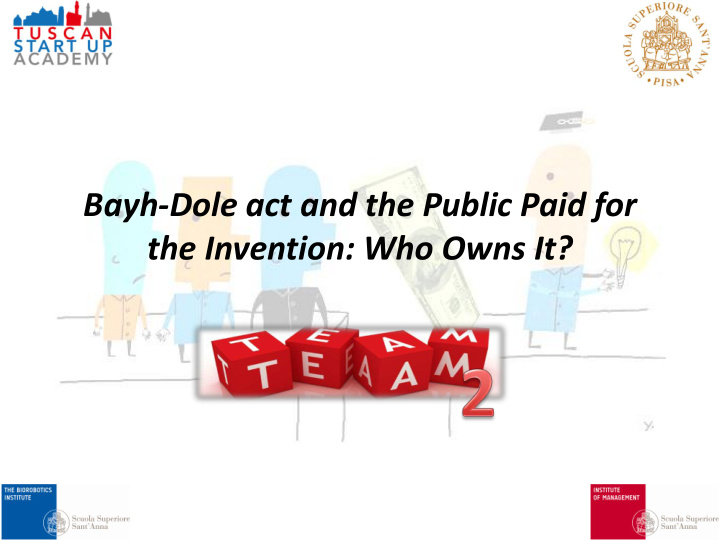



Bayh-Dole act and the Public Paid for the Invention: Who Owns It?
T HE U NIVERSITY R&D M ICROCOSMS
30 Y EARS AFTER BD BD in 1970s as re-conceptualization of public research as response to the rise of Japan BD acts in US, while more general reforms in EU European Paradox: spread of TLO vs weak patent activity Influence on the propensity of federal laboratories to patent C(orporate)SOs still works better than U(niversity)SOs Contribution of University-Level-Support Mechanisms (ULSM) is depending on the local settings
30 Y EARS AFTER BD: PRO AND CONS Pioneering character Inefficiencies License delays Promotion of Misaligned incentives technology Goal mismatch commercialization TLOS’S No decrement in basic Social interests research Entrepreneurship Increase in start-up inhibition activity
BD A CT AND H YPOTHETICAL S CENARIOS A professor wants to start her own A famous professor invents widget X at company to commercialize an invention University A. He later invents widget Y at by using federal funding . She thinks that University B. The two inventions are her invention is brilliant, whereas the commercially useful only when practiced university TLO thinks it is a dud. together. The professor is well connected to a company that is interested in producing widget X-Y. 1. The professor will retain the ownership, while university will 1. Try to negotiate the position in the apply the wait-and-see attitude second university by showing the 2. The professor will commercialize outstanding results of previous one the invention on his own (gray 2. With the BD act, the professor will market) leave invention to separate entities!
I NHERENT D YNAMICS IN BD A CT TLO side Inventor side • TLO should provide an administrative mechanism for ensuring compliance between BD • Assumption that TLO intrinsically and ownership better than inventors for attracting • TLOs are influenced by the collaborators and venture views of faculty and capitalists. administration making • Inventor could decide alternative this office ways such as private contracts. an agent!
T HE C ASE S TANFORD VS . R OCHE • In 2011, the Supreme Court held that patented invention vests first in the inventor, even if he is a researcher at a federally funded lab subject to the 1980 Bayh – Dole Act. • Once upon a time….. Dr. Mark Holodniy knowledge on HIV Ask for rights By means of own scientists • knwoledge on PCR • “ hereby assign ”
C ONSIDERATIONS FROM S TANFORD VS . R OCHE • Standford: Holodniy’s invention was funded in part by the federal government and therefore BD should automatically vest ownership in Stanford. • Roche: Holodniy provided a valid assignment to the company. • Supreme court: inventor remains the ab initio owner of his federally funded invention. Conclusions Is BD act always appropriate? the BD act seems to not defend the inventor rights the inventor ownership model seems to be more suitable
T HE I NVENTOR O WNERSHIP MODEL : A N E VOLUTION Kenney and Patton (2011) , Does inventor ownership encourage university research-derived entrepreneurship? A six university comparison, Research Policy, 40:1100-1112 1: Inventor ownership universities have a greater number of spin-offs than university ownership universities. 2: Inventor ownership universities have a greater number of spin-offs than their status, as measured by rankings would suggest, but this is conditioned by research fields.
W HEN THE F IELD MATTERS … 3: Inventor ownership universities, on an R&D expenditure basis, are more efficient at spinning- off firms than university ownership universities, but this is conditioned by field. 4: Inventor ownership universities, on a per faculty basis, is more efficient at spinning-off firms than university ownership universities, but this is conditioned by field. 5: In inventor ownership systems a lower percentage of spin-offs licenses technology from the university, but this is conditioned by field.
T HE CLASH OF CURRENT MODELS : BD A CT VS . I NVENTORS O WNERSHIP T HE “S WEDISH C ASE ” The Professor Privilege : The inventor has the IPR on his own invention, and he can decide to make over these rights to university. In principle, it should provide university employees the necessary incentives to commercialize their inventions. Swedish Paradox : Although Sweden is a world leader in R&D investment relative to GDP, its growth lagged the average for OECD countries. Entrepreneurship vs. Commercialization : Although the US system is less conducive to entrepreneurship than the Swedish system if established firms have some advantage over faculty start-ups, on average, the probability of successful commercialization is somewhat higher in the United States.
A REVERSE TREND : S HIFTING “ HIGHER UP ” THE IPR Society • Enhanced technological transfer • Social impact and improvement of societal issues Government • Positive impact on public opinion and more investments in R&D • Increased possibility of University commercialization of new ideas • Possibility of integration between academic environment and SMEs Inventor
“ Many had insisted that it was better for me to patent the vaccine. I did not. It is my gift to all children of the world.” Albert Bruce Sabin (1906-1993)
The Biorobotics Institute Management Institute Clara Genna Stefania Manetti Ilario Imbinto Chiara Oppi Antonio Ranaudo
Recommend
More recommend